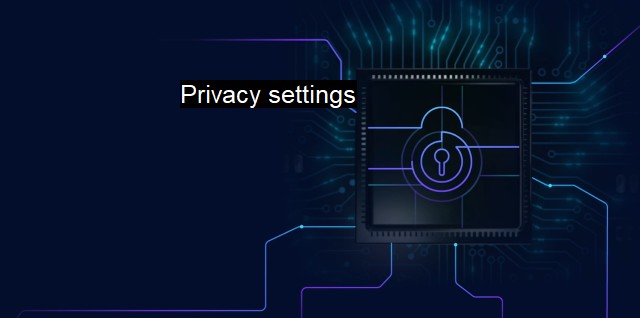What are Privacy settings?
The Importance of Privacy Settings for Safe Online Browsing and Maximizing Cybersecurity
Privacy settings are integral components of cybersecurity functioning as the primary gatekeepers of personal and organizational data. They are essentially an aspect of software or hardware that allows the user to define and regulate who can access and retrieve their stored data electronically.In the realm of technological innovation and digital transformation, internet security and privacy though seemingly distinct, occur concomitantly, substantially interconnected. While cybersecurity focuses more on safeguarding systems from methodological attack vectors, privacy settings control the narrative on data usage, sharing, and management. Privacy settings act as a bulwark supplementing cybersecurity efforts.
These settings can be adjusted within various software or programs including email services, web browsers, mobile apps, operating systems, and antivirus software. Privacy settings enable users to control their digital footprint, allowing the them to decide who can view and access their personal records while also protecting them from unauthorized surveillance.
Antivirus software also adopts privacy settings as a critical chain in its efforts to maintain data security. traditional antivirus software passively reacts to malicious threats. in today's digital era which is more proactive and prevalent concerning threats, antivirus software database is frequently updated and autonomously run analytic patterns, identifying potential threats beforehand. Here, privacy settings, form a proactive line of defense, dictating what personal or sensitive data can be accessed or shared.
In social networks or e-commerce platforms, privacy settings can dictate the diffusion of user's posts or private identifications, preventing uninvited media replications or the misuse of private data. When optimized correctly, these settings control public visibility, ad targeting, location sharing, and even message readability aspects.
Privacy settings have become crucial in the fleet of mobile applications and smartphones. With apps requesting access to various inbuilt sensors and user databases, maintaining privacy integrity becomes an uphill battle each time an app is installed. Here, privacy settings dictate which apps can access which tactile parts of the mobile device, henceforth controlling potential privacy bridges and forming an additional layer of web security.
Under GDPR laws, which aim at harmonizing data privacy laws across Europe, organizations have to ensure they adhere to privacy policies given the punitive implications of non-compliance. Privacy settings ensure fair and transparent processing of data. Hence, the user knows how their data is used, stored, managed, shared, or disposed of for business analytics or strategic decisions. It ensures data protection rights and builds upon the semblance of trust in overall cyber hygiene.
All these factors underscore that privacy settings are simply indispensable to any cybersecurity strategy. They provide an advanced level of protection beyond just a password and are dynamic in their approach towards defending personal and sensitive data.
Privacy settings form the bedrock of a pragmatic cybersecurity setup, combining firepower with antivirus software functionality and data protection regulations, translating to a robust remedial strategy endowed with preventive prowess. It melds transparency with security, ultimately empowering end-users. In a world that is weighed down by ever-evolving cyber threats, these settings prove that action towards data protection and privacy is always beneficial and that with correctly set privacy regulations, the fight against cybercrime becomes a shared responsibility facilitating a resilient cyber eco-system.

Privacy settings FAQs
What are privacy settings?
Privacy settings are controls that allow you to choose what information you want to share with others or keep private. These settings determine who can access and see your personal information, online activities, and preferences.Why are privacy settings important for cybersecurity and antivirus?
Privacy settings play a crucial role in safeguarding your online security and privacy. By setting your privacy preferences, you can protect your personal data from unauthorized access, malware, and cyber threats. This can help prevent identity theft, phishing, and other cyber attacks.How do I adjust my privacy settings?
The steps to adjust your privacy settings vary depending on the application or platform you are using. Generally, you can manage your privacy settings by going to your account settings or preferences and selecting the appropriate options. This may include settings for things like visibility of your profile, location data, and sharing with other users.What should I consider when adjusting my privacy settings?
When adjusting your privacy settings, it's important to consider the level of information you want to share, who you want to share it with, and the potential risks associated with sharing that information. It's also important to read the terms and conditions and understand what kind of data the application or platform collects, and how they use it.| | A | | | B | | | C | | | D | | | E | | | F | | | G | | | H | | | I | | | J | | | K | | | L | | | M | |
| | N | | | O | | | P | | | Q | | | R | | | S | | | T | | | U | | | V | | | W | | | X | | | Y | | | Z | |
| | 1 | | | 2 | | | 3 | | | 4 | | | 7 | | | 8 | | |||||||